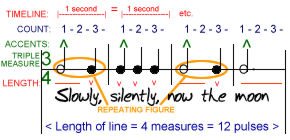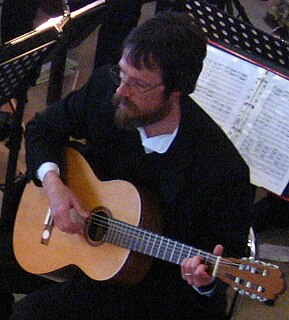
Figured bass is musical notation in which numerals and symbols appear above or below a bass note. The numerals and symbols indicate intervals, chords, and non-chord tones that a musician playing piano, harpsichord, organ, or lute should play in relation to the bass note. Figured bass is closely associated with basso continuo: a historically improvised accompaniment used in almost all genres of music in the Baroque period of Classical music, though rarely in modern music. Figured bass is also known as thoroughbass.

In music, just intonation or pure intonation is the tuning of musical intervals as whole number ratios of frequencies. An interval tuned in this way is said to be pure, and is called a just interval. Just intervals consist of tones from a single harmonic series of an implied fundamental. For example, in the diagram, if the notes G3 and C4 are tuned as members of the harmonic series of the lowest C, their frequencies will be 3 and 4 times the fundamental frequency. The interval ratio between C4 and G3 is therefore 4:3, a just fourth.

Music notation or musical notation is any system used to visually represent aurally perceived music played with instruments or sung by the human voice through the use of written, printed, or otherwise-produced symbols, including notation for durations of absence of sound such as rests.
The time signature is a notational convention used in Western musical notation to specify how many beats (pulses) are contained in each measure (bar), and which note value is equivalent to a beat.

In music, metre or meter refers to regularly recurring patterns and accents such as bars and beats. Unlike rhythm, metric onsets are not necessarily sounded, but are nevertheless implied by the performer and expected by the listener.
Sheet music is a handwritten or printed form of musical notation that uses musical symbols to indicate the pitches, rhythms, or chords of a song or instrumental musical piece. Like its analogs – printed books or pamphlets in English, Arabic, or other languages – the medium of sheet music typically is paper. However, access to musical notation since the 1980s has included the presentation of musical notation on computer screens and the development of scorewriter computer programs that can notate a song or piece electronically, and, in some cases, "play back" the notated music using a synthesizer or virtual instruments.

Polyrhythm is the simultaneous use of two or more rhythms that are not readily perceived as deriving from one another, or as simple manifestations of the same meter. The rhythmic layers may be the basis of an entire piece of music (cross-rhythm), or a momentary section. Polyrhythms can be distinguished from irrational rhythms, which can occur within the context of a single part; polyrhythms require at least two rhythms to be played concurrently, one of which is typically an irrational rhythm. Concurrently in this context means within the same rhythmic cycle. The underlying pulse, whether explicit or implicit can be considered one of the concurrent rhythms. For example, the son clave is poly-rhythmic because its 3 section suggests a different meter from the pulse of the entire pattern.

In musical notation, a bar is a segment of time corresponding to a specific number of beats in which each beat is represented by a particular note value and the boundaries of the bar are indicated by vertical bar lines. Dividing music into bars provides regular reference points to pinpoint locations within a musical composition. It also makes written music easier to follow, since each bar of staff symbols can be read and played as a batch.

Accompaniment is the musical part which provides the rhythmic and/or harmonic support for the melody or main themes of a song or instrumental piece. There are many different styles and types of accompaniment in different genres and styles of music. In homophonic music, the main accompaniment approach used in popular music, a clear vocal melody is supported by subordinate chords. In popular music and traditional music, the accompaniment parts typically provide the "beat" for the music and outline the chord progression of the song or instrumental piece.
Ear training or aural skills is a music theory study in which musicians learn to identify pitches, intervals, melody, chords, rhythms, solfeges, and other basic elements of music, solely by hearing. The application of this skill is analogous to taking dictation in written/spoken language. As a process, ear training is in essence the inverse of sight-reading, the latter being analogous to reading a written text aloud without prior opportunity to review the material. Ear training is typically a component of formal musical training and is a fundamental, essential skill required in music schools.
In music, a tuplet is "any rhythm that involves dividing the beat into a different number of equal subdivisions from that usually permitted by the time-signature " This is indicated by a number, or sometimes two indicating the fraction involved. The notes involved are also often grouped with a bracket or a slur.
A rest is a musical notation sign that indicates the absence of a sound.

Braille music is a braille code that allows music to be notated using braille cells so music can be read by visually impaired musicians. The system was incepted by Louis Braille.
The numbered musical notation is a cipher notation system used in China, and to some extent in Japan Indonesia, Malaysia, Australia, Ireland, the United Kingdom, the United States and English-speaking Canada. It dates back to the system designed by Pierre Galin, known as Galin-Paris-Chevé system. It is also known as Ziffernsystem, meaning "number system" or "cipher system" in German.

Mensural notation is the musical notation system used for European vocal polyphonic music from the later part of the 13th century until about 1600. The term "mensural" refers to the ability of this system to describe precisely measured rhythmic durations in terms of numerical proportions between note values. Its modern name is inspired by the terminology of medieval theorists, who used terms like musica mensurata or cantus mensurabilis to refer to the rhythmically defined polyphonic music of their age, as opposed to musica plana or musica choralis, i.e., Gregorian plainchant. Mensural notation was employed principally for compositions in the tradition of vocal polyphony, whereas plainchant retained its own, older system of neume notation throughout the period. Besides these, some purely instrumental music could be written in various forms of instrument-specific tablature notation.
Notation plays a relatively minor role in the oral traditions of Indonesian gamelan but, in Java and Bali, several systems of gamelan notation were devised beginning at the end of the 19th century, initially for archival purposes.
Percussion notation is a type of musical notation indicating notes to be played by percussion instruments. As with other forms of musical notation, sounds are represented by symbols which are usually written onto a musical staff.
Arabic maqam is the system of melodic modes used in traditional Arabic music, which is mainly melodic. The word maqam in Arabic means place, location or position. The Arabic maqam is a melody type. It is "a technique of improvisation" that defines the pitches, patterns, and development of a piece of music and is "unique to Arabian art music". There are 72 heptatonic tone rows or scales of maqamat. These are constructed from major, neutral, and minor seconds. Each maqam is built on a scale, and carries a tradition that defines its habitual phrases, important notes, melodic development and modulation. Both compositions and improvisations in traditional Arabic music are based on the maqam system. Maqamat can be realized with either vocal or instrumental music, and do not include a rhythmic component.
Musicians use various kinds of chord names and symbols in different contexts to represent musical chords. In most genres of popular music, including jazz, pop, and rock, a chord name and its corresponding symbol typically indicate one or more of the following:
- the root note,
- the chord quality,
- whether the chord is a triad, seventh chord, or an extended chord,
- any altered notes,
- any added tones, and
- the bass note if it is not the root.










